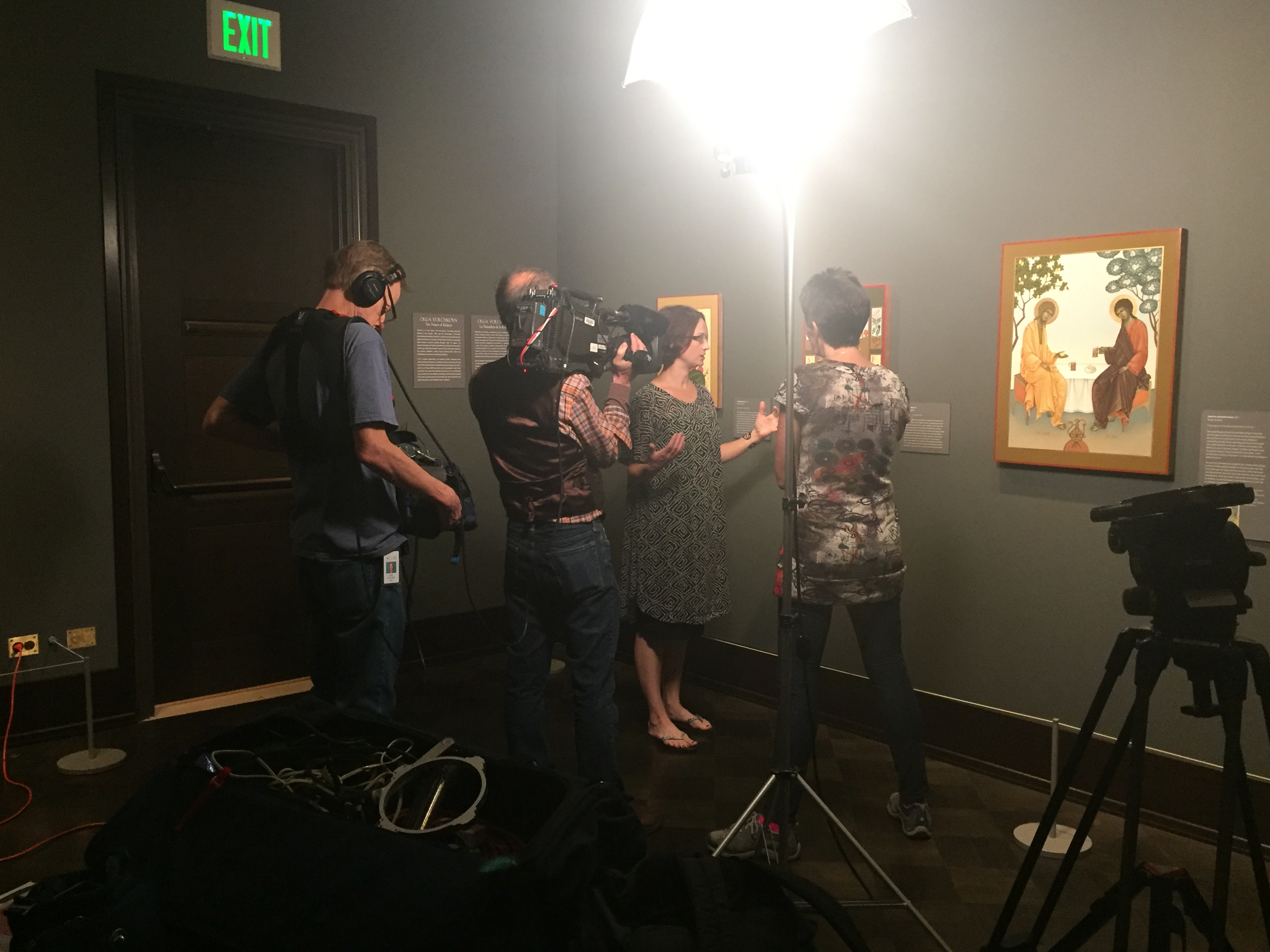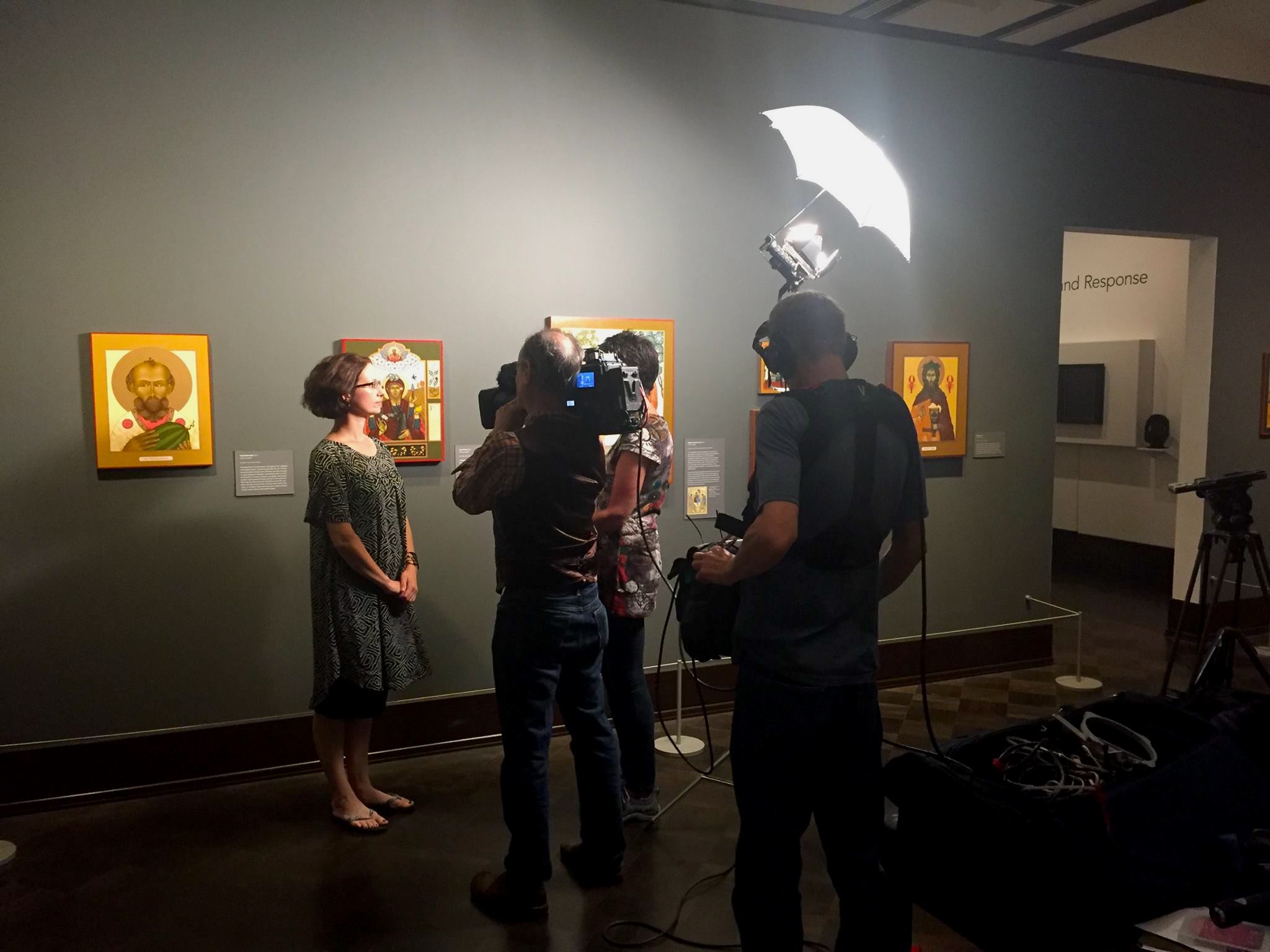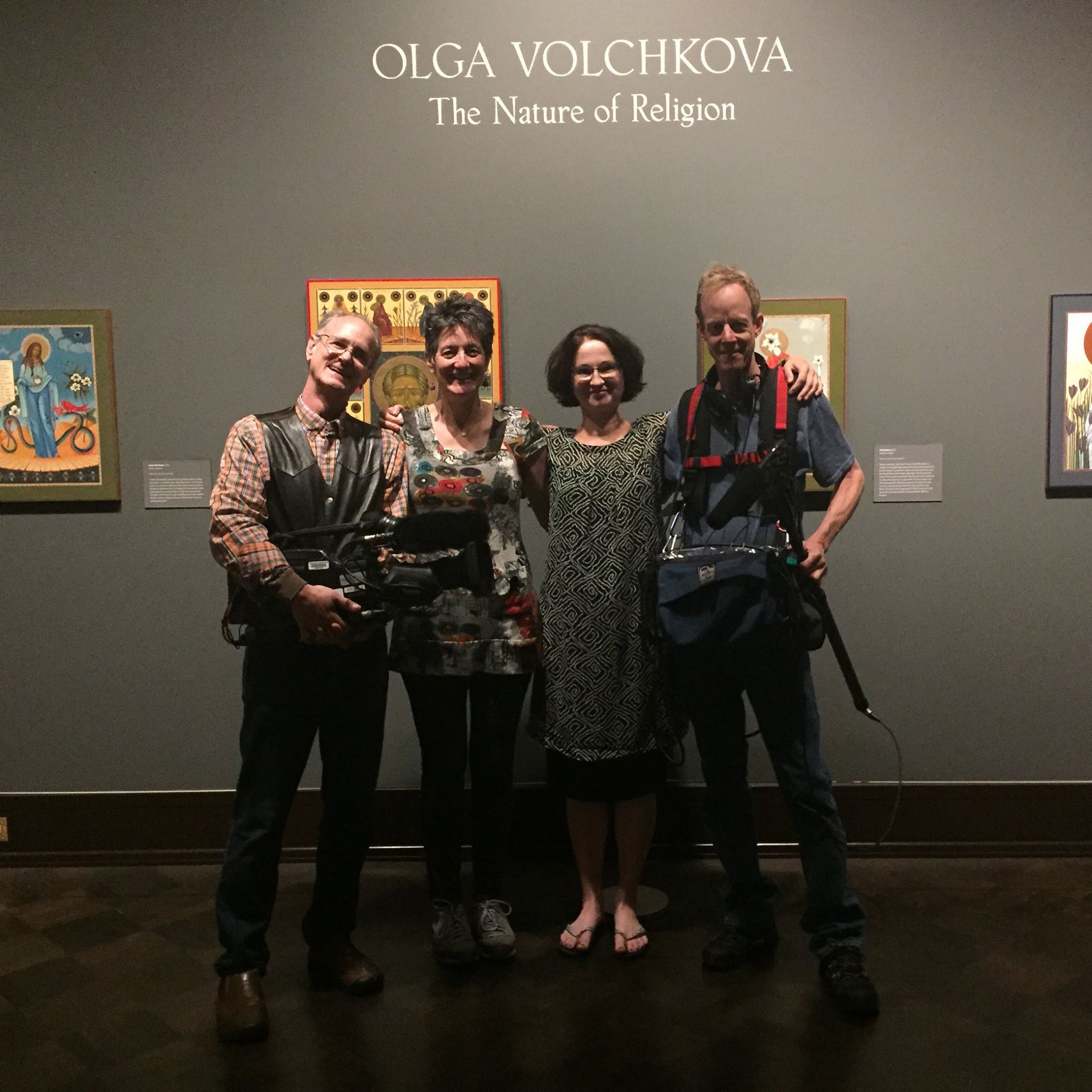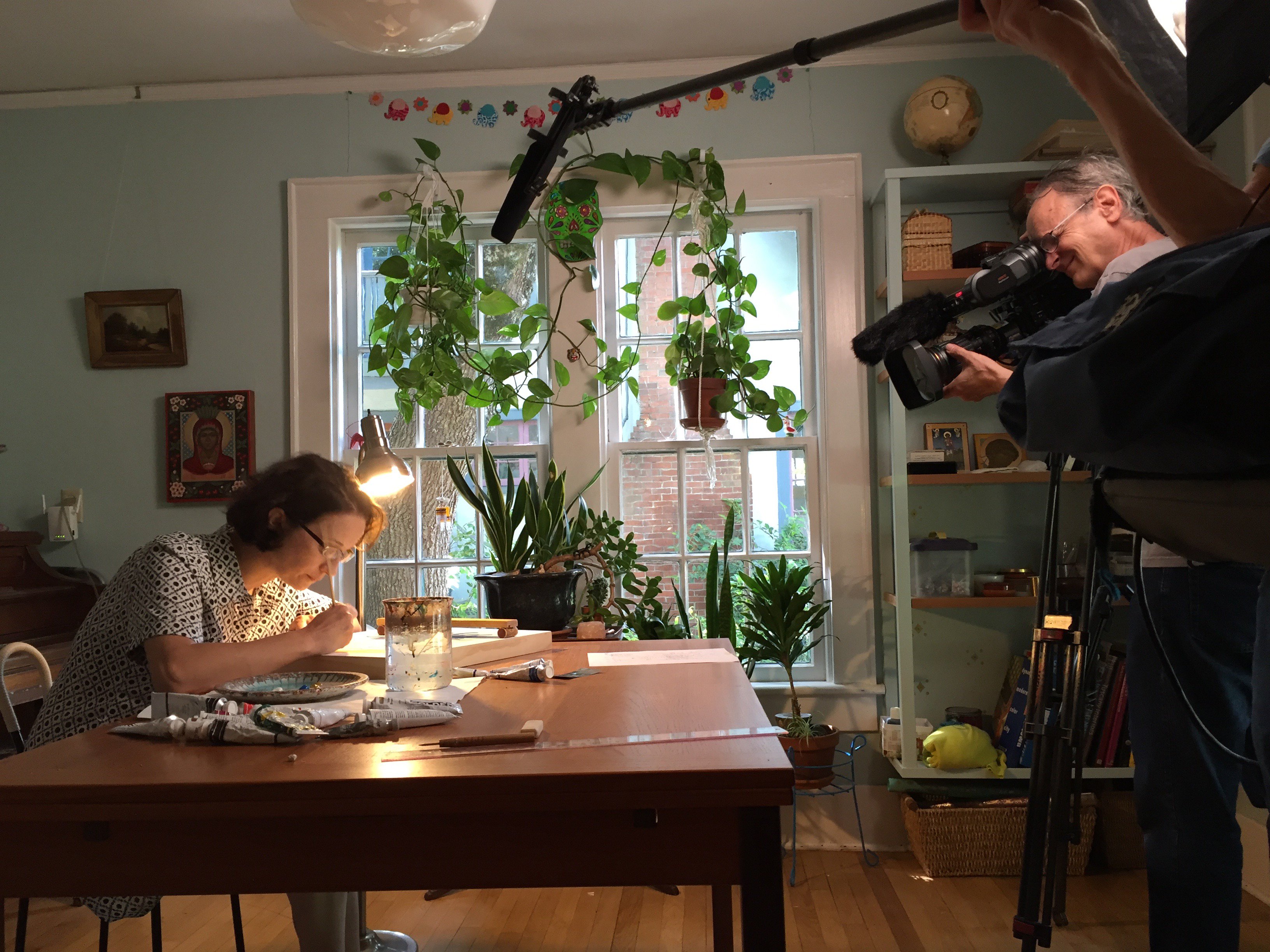PBS
KOPB
KQED
WNET
KRMA, KTSC, KRMJ, KRMU, KRMZ
KSYS



 Tonight on Oregon Art Beat, look closer.
Traditional art, but it's not what you think.
KATRINA SARSON: Russian icons get a decidedly modern twist
in Eugene.
OLGA VOLCHKOVA: Basically, I'm canonizing plants.
JULE GILFILLAN: A playful take on 18th-century porcelain
in the Wallowas.
WOMAN: The work is from a woman,
about being female in this world.
ERIC SLADE: And a metalsmith soups up hot rods in the Gorge.
[ laughs ]
Oregon Art Beat starts now!
OLGA VOLCHKOVA: Here's a flying ointment.
Here's a dragon, and he is holding six berries.
It's enough berries to kill human beings.
I'm trying to paint the whole series
of these deadly nightshades,
because all of them have fascinating stories.
Even reading all names of belladonna
gives you some ideas what to paint.
All plants from nightshade family are very deadly.
So it's all about beautiful and deadly.
People have been painting icons in Russia
at least a thousand years.
I paint pretty much the same way,
but I don't have it as a goal
to exactly match technique of traditional icons.
Just some parts of it I find very useful.
KATRINA SARSON: Olga Vochkova grew up in a city north of Moscow
during the 1970s and '80s.
OLGA VOLCHKOVA: We have a big vegetable garden, we have orchards,
we have river, we have forest, bicycle.
My favorite thing would be mushroom picking.
KATRINA SARSON: She finished high school just three years
before the Soviet Union collapsed in 1991.
OLGA VOLCHKOVA: So no jobs, no factories. Everything collapsed.
The whole economy collapsed.
And as a young girl, I wanted --
you know, some pretty things to buy for myself,
so I had to make money somehow.
And as a group of friends, we started to paint matryoshkas
and sell them to tourists.
That's how I got into art.
KATRINA SARSON: A couple of years later, a training program for artists
was offered in her hometown.
OLGA VOLCHKOVA: Competition was huge.
I really didn't believe that I would be able to...
and I was one of the eight lucky people.
So we had kind of a classical training.
It was drawing and painting, kind of academic style.
Icon paintings, you also start from a beginning,
start with all elements of icons,
and then you kind of put it together.
During Soviet times, religion was not in favor, really.
Officially, it was legal, but really it wasn't.
So when Christianity was coming back again to Russia,
it feels like magic.
PROFESSOR: The key of a traditional Russian Orthodox icon
is it borrows from this centuries-old tradition
going back to the Byzantine Empire.
So it's not an artwork as we think of an artwork,
something that might be appreciated
as beautiful or interesting or bought and sold.
Think of it more as a... liturgical vessel
through which one connects with God.
Icons are often anonymous.
The artist doesn't matter.
What matters is the depiction and how it kind of connects
with this centuries-old tradition,
and that's part of what gives it its validity.
I think her work, on an artistic level,
is clearly very engaged with, and, in that way,
respectful of this tradition.
And clearly she's deeply appreciative of the beauty
of an Orthodox icon.
OLGA VOLCHKOVA: What I've learned in icon school,
each step you do, it has to look balanced and harmonious.
So that's when you have success.
KATRINA SARSON:
One day after moving to the United States,
Olga had an idea.
She combined the tradition of icon painting
with her love of nature
and created a whole new body of work.
OLGA VOLCHKOVA:
Sometimes I'm just fascinated
with the beauty of a plant itself,
and that would be enough.
Or it could be personal stories that some plants or vegetables,
they kind of helped me in my life.
That's an image of St. Potato.
Potato is the most common vegetable
pretty much everywhere, and I just remember
since my childhood we had huge potato fields
and we were producing a lot of potatoes.
Here's a llama.
It represents the origin of potato.
Here is a potato god.
It's for him to decide
if we're going to have harvest this year or not.
And also she is holding potato "Spudnik,"
because potato is the first vegetable grown in space.
At some point, you stop seeing things.
Just run away, go to my garden, and do something physical.
It's both exercise, also meditation...
[ inhales deeply ]
just to see how your plants are doing,
if they're healthy or not.
Yes, connection to the world.
Five months; that's the biggest painting so far I've done.
But I would love to go bigger
and just to create, three years, one painting.
If I get some crazy grant somewhere to do it,
I would do it.
From my research, I think I'm pretty much the first one
who paints these kind of icons.
And, basically, I'm canonizing plants.
I don't think anyone dared before.
[ chuckles ]
Tonight on Oregon Art Beat, look closer.
Traditional art, but it's not what you think.
KATRINA SARSON: Russian icons get a decidedly modern twist
in Eugene.
OLGA VOLCHKOVA: Basically, I'm canonizing plants.
JULE GILFILLAN: A playful take on 18th-century porcelain
in the Wallowas.
WOMAN: The work is from a woman,
about being female in this world.
ERIC SLADE: And a metalsmith soups up hot rods in the Gorge.
[ laughs ]
Oregon Art Beat starts now!
OLGA VOLCHKOVA: Here's a flying ointment.
Here's a dragon, and he is holding six berries.
It's enough berries to kill human beings.
I'm trying to paint the whole series
of these deadly nightshades,
because all of them have fascinating stories.
Even reading all names of belladonna
gives you some ideas what to paint.
All plants from nightshade family are very deadly.
So it's all about beautiful and deadly.
People have been painting icons in Russia
at least a thousand years.
I paint pretty much the same way,
but I don't have it as a goal
to exactly match technique of traditional icons.
Just some parts of it I find very useful.
KATRINA SARSON: Olga Vochkova grew up in a city north of Moscow
during the 1970s and '80s.
OLGA VOLCHKOVA: We have a big vegetable garden, we have orchards,
we have river, we have forest, bicycle.
My favorite thing would be mushroom picking.
KATRINA SARSON: She finished high school just three years
before the Soviet Union collapsed in 1991.
OLGA VOLCHKOVA: So no jobs, no factories. Everything collapsed.
The whole economy collapsed.
And as a young girl, I wanted --
you know, some pretty things to buy for myself,
so I had to make money somehow.
And as a group of friends, we started to paint matryoshkas
and sell them to tourists.
That's how I got into art.
KATRINA SARSON: A couple of years later, a training program for artists
was offered in her hometown.
OLGA VOLCHKOVA: Competition was huge.
I really didn't believe that I would be able to...
and I was one of the eight lucky people.
So we had kind of a classical training.
It was drawing and painting, kind of academic style.
Icon paintings, you also start from a beginning,
start with all elements of icons,
and then you kind of put it together.
During Soviet times, religion was not in favor, really.
Officially, it was legal, but really it wasn't.
So when Christianity was coming back again to Russia,
it feels like magic.
PROFESSOR: The key of a traditional Russian Orthodox icon
is it borrows from this centuries-old tradition
going back to the Byzantine Empire.
So it's not an artwork as we think of an artwork,
something that might be appreciated
as beautiful or interesting or bought and sold.
Think of it more as a... liturgical vessel
through which one connects with God.
Icons are often anonymous.
The artist doesn't matter.
What matters is the depiction and how it kind of connects
with this centuries-old tradition,
and that's part of what gives it its validity.
I think her work, on an artistic level,
is clearly very engaged with, and, in that way,
respectful of this tradition.
And clearly she's deeply appreciative of the beauty
of an Orthodox icon.
OLGA VOLCHKOVA: What I've learned in icon school,
each step you do, it has to look balanced and harmonious.
So that's when you have success.
KATRINA SARSON:
One day after moving to the United States,
Olga had an idea.
She combined the tradition of icon painting
with her love of nature
and created a whole new body of work.
OLGA VOLCHKOVA:
Sometimes I'm just fascinated
with the beauty of a plant itself,
and that would be enough.
Or it could be personal stories that some plants or vegetables,
they kind of helped me in my life.
That's an image of St. Potato.
Potato is the most common vegetable
pretty much everywhere, and I just remember
since my childhood we had huge potato fields
and we were producing a lot of potatoes.
Here's a llama.
It represents the origin of potato.
Here is a potato god.
It's for him to decide
if we're going to have harvest this year or not.
And also she is holding potato "Spudnik,"
because potato is the first vegetable grown in space.
At some point, you stop seeing things.
Just run away, go to my garden, and do something physical.
It's both exercise, also meditation...
[ inhales deeply ]
just to see how your plants are doing,
if they're healthy or not.
Yes, connection to the world.
Five months; that's the biggest painting so far I've done.
But I would love to go bigger
and just to create, three years, one painting.
If I get some crazy grant somewhere to do it,
I would do it.
From my research, I think I'm pretty much the first one
who paints these kind of icons.
And, basically, I'm canonizing plants.
I don't think anyone dared before.
[ chuckles ]



 Tonight on Oregon Art Beat, look closer.
Traditional art, but it's not what you think.
KATRINA SARSON: Russian icons get a decidedly modern twist
in Eugene.
OLGA VOLCHKOVA: Basically, I'm canonizing plants.
JULE GILFILLAN: A playful take on 18th-century porcelain
in the Wallowas.
WOMAN: The work is from a woman,
about being female in this world.
ERIC SLADE: And a metalsmith soups up hot rods in the Gorge.
[ laughs ]
Oregon Art Beat starts now!
OLGA VOLCHKOVA: Here's a flying ointment.
Here's a dragon, and he is holding six berries.
It's enough berries to kill human beings.
I'm trying to paint the whole series
of these deadly nightshades,
because all of them have fascinating stories.
Even reading all names of belladonna
gives you some ideas what to paint.
All plants from nightshade family are very deadly.
So it's all about beautiful and deadly.
People have been painting icons in Russia
at least a thousand years.
I paint pretty much the same way,
but I don't have it as a goal
to exactly match technique of traditional icons.
Just some parts of it I find very useful.
KATRINA SARSON: Olga Vochkova grew up in a city north of Moscow
during the 1970s and '80s.
OLGA VOLCHKOVA: We have a big vegetable garden, we have orchards,
we have river, we have forest, bicycle.
My favorite thing would be mushroom picking.
KATRINA SARSON: She finished high school just three years
before the Soviet Union collapsed in 1991.
OLGA VOLCHKOVA: So no jobs, no factories. Everything collapsed.
The whole economy collapsed.
And as a young girl, I wanted --
you know, some pretty things to buy for myself,
so I had to make money somehow.
And as a group of friends, we started to paint matryoshkas
and sell them to tourists.
That's how I got into art.
KATRINA SARSON: A couple of years later, a training program for artists
was offered in her hometown.
OLGA VOLCHKOVA: Competition was huge.
I really didn't believe that I would be able to...
and I was one of the eight lucky people.
So we had kind of a classical training.
It was drawing and painting, kind of academic style.
Icon paintings, you also start from a beginning,
start with all elements of icons,
and then you kind of put it together.
During Soviet times, religion was not in favor, really.
Officially, it was legal, but really it wasn't.
So when Christianity was coming back again to Russia,
it feels like magic.
PROFESSOR: The key of a traditional Russian Orthodox icon
is it borrows from this centuries-old tradition
going back to the Byzantine Empire.
So it's not an artwork as we think of an artwork,
something that might be appreciated
as beautiful or interesting or bought and sold.
Think of it more as a... liturgical vessel
through which one connects with God.
Icons are often anonymous.
The artist doesn't matter.
What matters is the depiction and how it kind of connects
with this centuries-old tradition,
and that's part of what gives it its validity.
I think her work, on an artistic level,
is clearly very engaged with, and, in that way,
respectful of this tradition.
And clearly she's deeply appreciative of the beauty
of an Orthodox icon.
OLGA VOLCHKOVA: What I've learned in icon school,
each step you do, it has to look balanced and harmonious.
So that's when you have success.
KATRINA SARSON:
One day after moving to the United States,
Olga had an idea.
She combined the tradition of icon painting
with her love of nature
and created a whole new body of work.
OLGA VOLCHKOVA:
Sometimes I'm just fascinated
with the beauty of a plant itself,
and that would be enough.
Or it could be personal stories that some plants or vegetables,
they kind of helped me in my life.
That's an image of St. Potato.
Potato is the most common vegetable
pretty much everywhere, and I just remember
since my childhood we had huge potato fields
and we were producing a lot of potatoes.
Here's a llama.
It represents the origin of potato.
Here is a potato god.
It's for him to decide
if we're going to have harvest this year or not.
And also she is holding potato "Spudnik,"
because potato is the first vegetable grown in space.
At some point, you stop seeing things.
Just run away, go to my garden, and do something physical.
It's both exercise, also meditation...
[ inhales deeply ]
just to see how your plants are doing,
if they're healthy or not.
Yes, connection to the world.
Five months; that's the biggest painting so far I've done.
But I would love to go bigger
and just to create, three years, one painting.
If I get some crazy grant somewhere to do it,
I would do it.
From my research, I think I'm pretty much the first one
who paints these kind of icons.
And, basically, I'm canonizing plants.
I don't think anyone dared before.
[ chuckles ]
Tonight on Oregon Art Beat, look closer.
Traditional art, but it's not what you think.
KATRINA SARSON: Russian icons get a decidedly modern twist
in Eugene.
OLGA VOLCHKOVA: Basically, I'm canonizing plants.
JULE GILFILLAN: A playful take on 18th-century porcelain
in the Wallowas.
WOMAN: The work is from a woman,
about being female in this world.
ERIC SLADE: And a metalsmith soups up hot rods in the Gorge.
[ laughs ]
Oregon Art Beat starts now!
OLGA VOLCHKOVA: Here's a flying ointment.
Here's a dragon, and he is holding six berries.
It's enough berries to kill human beings.
I'm trying to paint the whole series
of these deadly nightshades,
because all of them have fascinating stories.
Even reading all names of belladonna
gives you some ideas what to paint.
All plants from nightshade family are very deadly.
So it's all about beautiful and deadly.
People have been painting icons in Russia
at least a thousand years.
I paint pretty much the same way,
but I don't have it as a goal
to exactly match technique of traditional icons.
Just some parts of it I find very useful.
KATRINA SARSON: Olga Vochkova grew up in a city north of Moscow
during the 1970s and '80s.
OLGA VOLCHKOVA: We have a big vegetable garden, we have orchards,
we have river, we have forest, bicycle.
My favorite thing would be mushroom picking.
KATRINA SARSON: She finished high school just three years
before the Soviet Union collapsed in 1991.
OLGA VOLCHKOVA: So no jobs, no factories. Everything collapsed.
The whole economy collapsed.
And as a young girl, I wanted --
you know, some pretty things to buy for myself,
so I had to make money somehow.
And as a group of friends, we started to paint matryoshkas
and sell them to tourists.
That's how I got into art.
KATRINA SARSON: A couple of years later, a training program for artists
was offered in her hometown.
OLGA VOLCHKOVA: Competition was huge.
I really didn't believe that I would be able to...
and I was one of the eight lucky people.
So we had kind of a classical training.
It was drawing and painting, kind of academic style.
Icon paintings, you also start from a beginning,
start with all elements of icons,
and then you kind of put it together.
During Soviet times, religion was not in favor, really.
Officially, it was legal, but really it wasn't.
So when Christianity was coming back again to Russia,
it feels like magic.
PROFESSOR: The key of a traditional Russian Orthodox icon
is it borrows from this centuries-old tradition
going back to the Byzantine Empire.
So it's not an artwork as we think of an artwork,
something that might be appreciated
as beautiful or interesting or bought and sold.
Think of it more as a... liturgical vessel
through which one connects with God.
Icons are often anonymous.
The artist doesn't matter.
What matters is the depiction and how it kind of connects
with this centuries-old tradition,
and that's part of what gives it its validity.
I think her work, on an artistic level,
is clearly very engaged with, and, in that way,
respectful of this tradition.
And clearly she's deeply appreciative of the beauty
of an Orthodox icon.
OLGA VOLCHKOVA: What I've learned in icon school,
each step you do, it has to look balanced and harmonious.
So that's when you have success.
KATRINA SARSON:
One day after moving to the United States,
Olga had an idea.
She combined the tradition of icon painting
with her love of nature
and created a whole new body of work.
OLGA VOLCHKOVA:
Sometimes I'm just fascinated
with the beauty of a plant itself,
and that would be enough.
Or it could be personal stories that some plants or vegetables,
they kind of helped me in my life.
That's an image of St. Potato.
Potato is the most common vegetable
pretty much everywhere, and I just remember
since my childhood we had huge potato fields
and we were producing a lot of potatoes.
Here's a llama.
It represents the origin of potato.
Here is a potato god.
It's for him to decide
if we're going to have harvest this year or not.
And also she is holding potato "Spudnik,"
because potato is the first vegetable grown in space.
At some point, you stop seeing things.
Just run away, go to my garden, and do something physical.
It's both exercise, also meditation...
[ inhales deeply ]
just to see how your plants are doing,
if they're healthy or not.
Yes, connection to the world.
Five months; that's the biggest painting so far I've done.
But I would love to go bigger
and just to create, three years, one painting.
If I get some crazy grant somewhere to do it,
I would do it.
From my research, I think I'm pretty much the first one
who paints these kind of icons.
And, basically, I'm canonizing plants.
I don't think anyone dared before.
[ chuckles ]